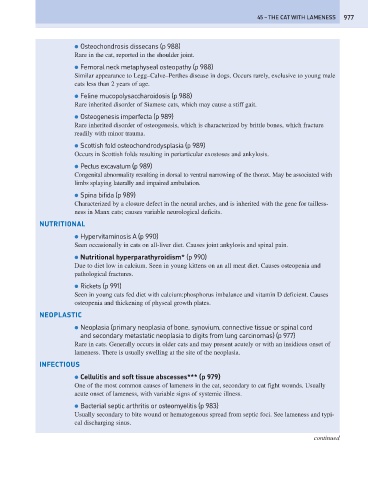Page 985 - Problem-Based Feline Medicine
P. 985
45 – THE CAT WITH LAMENESS 977
● Osteochondrosis dissecans (p 988)
Rare in the cat, reported in the shoulder joint.
● Femoral neck metaphyseal osteopathy (p 988)
Similar appearance to Legg–Calve–Perthes disease in dogs. Occurs rarely, exclusive to young male
cats less than 2 years of age.
● Feline mucopolysaccharoidosis (p 988)
Rare inherited disorder of Siamese cats, which may cause a stiff gait.
● Osteogenesis imperfecta (p 989)
Rare inherited disorder of osteogenesis, which is characterized by brittle bones, which fracture
readily with minor trauma.
● Scottish fold osteochondrodysplasia (p 989)
Occurs in Scottish folds resulting in periarticular exostoses and ankylosis.
● Pectus excavatum (p 989)
Congenital abnormality resulting in dorsal to ventral narrowing of the thorax. May be associated with
limbs splaying laterally and impaired ambulation.
● Spina bifida (p 989)
Characterized by a closure defect in the neural arches, and is inherited with the gene for tailless-
ness in Manx cats; causes variable neurological deficits.
NUTRITIONAL
● Hypervitaminosis A (p 990)
Seen occasionally in cats on all-liver diet. Causes joint ankylosis and spinal pain.
● Nutritional hyperparathyroidism* (p 990)
Due to diet low in calcium. Seen in young kittens on an all meat diet. Causes osteopenia and
pathological fractures.
● Rickets (p 991)
Seen in young cats fed diet with calcium:phosphorus imbalance and vitamin D deficient. Causes
osteopenia and thickening of physeal growth plates.
NEOPLASTIC
● Neoplasia (primary neoplasia of bone, synovium, connective tissue or spinal cord
and secondary metastatic neoplasia to digits from lung carcinomas) (p 977)
Rare in cats. Generally occurs in older cats and may present acutely or with an insidious onset of
lameness. There is usually swelling at the site of the neoplasia.
INFECTIOUS
● Cellulitis and soft tissue abscesses*** (p 979)
One of the most common causes of lameness in the cat, secondary to cat fight wounds. Usually
acute onset of lameness, with variable signs of systemic illness.
● Bacterial septic arthritis or osteomyelitis (p 983)
Usually secondary to bite wound or hematogenous spread from septic foci. See lameness and typi-
cal discharging sinus.
continued

